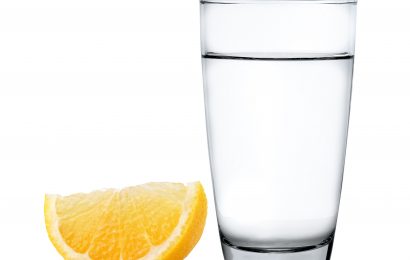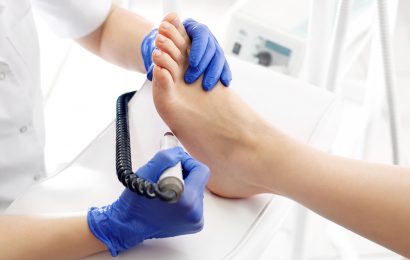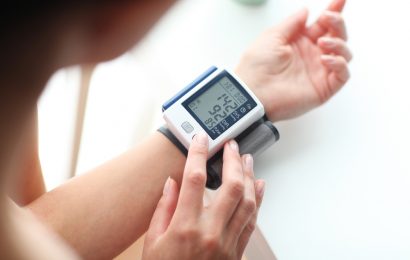If your doctor has told you that you have high blood pressure, or hypertension, you may well have groaned at the thought of more dietary restrictions and/or another pill to take. Or maybe you just tuned him out. After all, you have enough to do with caring for your diabetes, and how serious could high blood pressure be, anyway, since it has no symptoms?
In fact, high blood pressure is very serious. But paying attention to it now can save you a lot of grief down the road.
Why it matters
High blood pressure is one of the most important risk factors for stroke, heart attack, and kidney failure in people with diabetes. While the relationship between high blood pressure and diabetes is not fully understood, it is known that high blood pressure is two times more common in people with diabetes than in the general population. More than half of people with Type 2 diabetes already have high blood pressure at the time of their diabetes diagnosis.
In a person with diabetes, high blood pressure accelerates the blood vessel damage caused by high blood glucose. High blood pressure contributes to more than two-thirds of the serious and life-threatening complications of diabetes, including stroke, heart attack, and kidney failure. However, numerous studies have shown that treating high blood pressure aggressively substantially reduces the risk of death from stroke and heart attack.
For people with diabetes, the goal for blood pressure control is to keep it below 140/90 mm Hg. This target was established on the basis of large-scale studies that showed significant reductions in stroke and heart disease when blood pressure was maintained at this level. However, studies also suggest that blood pressure goals are not being met: Only about half of people with diabetes are reaching this goal consistently.
Understanding blood pressure
The heart pumps blood through more than 93 miles of blood vessels, which act as a plumbing system, carrying blood to all the vital organs. A certain amount of pressure within this system is necessary to keep the blood moving, but too much pressure can damage the vessels and organs. If the heart pumps too hard or the body’s smaller blood vessels become narrow, the pressure rises. If a person’s blood pressure is persistently elevated, the diagnosis of high blood pressure is made.
Blood pressure is measured in millimeters of mercury (mm Hg). The first, or “top,” number is the systolic pressure and measures the force on the blood vessel walls as the heart squeezes, or contracts. The second, or “lower,” number is the diastolic pressure, which is the force on the vessel walls as the heart relaxes. A person’s blood pressure is categorized as normal, prehypertensive (high-normal), or hypertensive. The hypertensive group is further divided into stage 1 and stage 2, based on how high the measurements are above normal. Stage 1 refers to blood pressure levels from 140/90 mm Hg to 159/99 mm Hg. Stage 2 refers to blood pressure levels of 160/100 mm Hg or higher.
Blood pressure is very dynamic, meaning that it can change instantaneously in response to the internal or external environment. For example, if you have an injury that causes severe bleeding, your blood pressure drops rapidly. But your body also responds to that drop within seconds by squeezing and narrowing the blood vessels and increasing heart activity to bring the pressure back up.
The body has numerous ways of adjusting blood pressure as needed to be sure its organs (primarily the brain) maintain a good supply of oxygen. This dynamic response is part of the reason some people have what is called white-coat hypertension. Being nervous in the medical office can result in a substantial increase in blood pressure that is not present at home. White-coat hypertension can make it difficult to get an accurate blood pressure measurement.
For the most accurate blood pressure measurement at a medical appointment, it’s best to sit quietly and rest for at least five minutes before having your blood pressure measured. Smoking and caffeine both raise blood pressure, so avoid both for at least an hour before your appointment. (Ideally, smoking should be avoided for life, so if you smoke, talk to your doctor about quitting if you haven’t already.)
When your blood pressure is measured, your arm should be at the level of your heart, and the blood pressure cuff should be sized appropriately for your arm. If the cuff just barely fits around your arm or pops off once it is in place, it may be too small, and you are likely to get a falsely elevated reading. Two readings are often sufficient at a medical visit, but at times, a reading taken at the end of the visit is most accurate because you are more relaxed.
It’s a good idea to write down your blood pressure readings taken at the doctor’s office, both for your own information, and to show to any other health-care providers you may see. This helps your health-care providers coordinate their care and see whether the measurements they’re getting are typical for you. It’s also important to discuss your blood pressure goal with the various members of your health-care team to be sure you’re all shooting for the goal established for people who have diabetes, less than 140/90 mm Hg. If you find that different members of your team have different goals in mind, you may need to take the lead in letting everyone know what your goal is.
Measuring your blood pressure at home is also very valuable, especially during periods of medication adjustments. Home blood pressure monitors typically cost about $40 to $60, and they are well worth the investment. Wrist monitors may not be as reliable as those that have a cuff that wraps around the upper arm. If you use a home blood pressure monitor, you should bring it to your doctor appointments periodically to be sure it is accurate. A good time to monitor at home is in the morning before you take any medicines. Early morning is when blood pressure tends to be highest and when the effects of some drugs are wearing off. It is also the highest risk period for stroke and heart attack.
Another tool that is often used to diagnose high blood pressure is the 24-hour ambulatory blood pressure monitor. This is a blood pressure monitor that is clipped onto a belt and connected to an arm cuff for a 24-hour period. Depending on how it is programmed, the cuff automatically inflates every 20–60 minutes to measure and record blood pressure throughout the day and night. It is a very useful tool to assess people with white-coat hypertension, difficult-to-control high blood pressure, or symptoms of low blood pressure (which may mean that a person’s high blood pressure is being overtreated). Measuring blood pressure while a person is asleep is important because blood pressure is expected to drop by about 10% to 20% at night. This is called a nocturnal dip. Absence of the nocturnal dip is associated with a higher risk of heart disease and stroke.
Types of high blood pressure
As stated earlier, the goal blood pressure for people with diabetes is less than 140/90 mm Hg consistently. That means the highest reading you should see is 139/89 mm Hg. Persistent readings above this target should prompt a focused evaluation of your blood pressure by you and your health-care team. The initial evaluation covers three major issues: identifying the cause of high blood pressure, looking for evidence of organ damage that may have already taken place, and discussing lifestyle issues that may be affecting blood pressure.
The causes of high blood pressure are divided into two broad groups. The first group is called primary, or essential, hypertension. This is the most common form of high blood pressure, and the exact cause is not clearly understood. However, it is believed to be due in part to a combination of genetic and environmental factors. Having diabetes may amplify some of these factors. In people with Type 1 diabetes, kidney disease is also believed to play a central role in the progression of high blood pressure. In people with Type 2 diabetes, obesity and insulin resistance may be important factors. However, it should be noted that some studies show a stronger connection between high blood pressure and diabetes in people with Type 2 diabetes who are thin.
The second form of high blood pressure is appropriately called secondary hypertension, and while it is less common, it is at times curable without the need for long-term drug treatment. There is a long list of conditions and medicines that can cause secondary hypertension. Kidney disease is probably the most common form of secondary hypertension. The kidneys are supplied by two main kidney arteries, and when a kidney artery develops a narrowing, the kidney “believes” your blood pressure is too low. It then sends signals to raise your blood pressure inappropriately. This is called renal (kidney) artery hypertension. Opening the blocked artery with a balloon and stent (a sort of medical scaffolding) can cure this type of high blood pressure in some cases.
Sleep apnea, thyroid disease, and certain hormone-producing tumors can lead to high blood pressure as well. Some prescription and over-the-counter drugs can also raise blood pressure. Steroids, non-steroidal anti-inflammatory drugs (NSAIDs, such as ibuprofen), and certain cold medicines (including those containing pseudoephedrine) are a few of the more common culprits. Oral contraceptives are also associated with high blood pressure in women, especially women who smoke or are obese.
High blood pressure is often called “the silent killer,” because even while it is damaging your organs, it usually does not cause any symptoms. That’s why an important part of the initial evaluation of high blood pressure is identifying any damage that has already been caused by it. Constantly pumping against a very high pressure can strain the heart and cause it to become enlarged, or hypertrophied. An enlarged heart is associated with an increased risk of heart attack, heart failure, sudden death, and stroke. An electrocardiogram or echocardiogram (heart ultrasound) can identify this complication. Constantly filtering under high pressure can lead to kidney damage, resulting in abnormal kidney function and the leakage of protein into the urine. These types of complications of high blood pressure are called end-organ damage, but they can potentially improve with aggressive treatment of the high blood pressure.
Essential hypertension generally progresses very slowly over years. This is in sharp contrast to secondary hypertension, which more frequently progresses quickly over months, weeks, or even days, leading to a rapid rise in blood pressure. This is termed accelerated hypertension and can be associated with symptoms such as headache, nausea, visual problems, confusion, or drowsiness. Anyone with rapidly worsening blood pressure and significant symptoms should be evaluated immediately by their physician. The pace of the blood pressure rise can be an important clue to the cause.
Treating high blood pressure
Once high blood pressure is diagnosed, a treatment program should begin immediately. In cases where the blood pressure is very elevated (as in stage 2 hypertension, with systolic blood pressure higher than 160 mm Hg), drug therapy is often initiated right away while lab tests and x-ray studies are obtained. When a person is found to have secondary hypertension, treatment is directed at the cause. For example, if a person is found to have a kidney artery blockage causing hypertension, he will be considered for a procedure to open the blocked kidney artery.
If a curable form of hypertension is found and treated, long-term drug therapy may be avoided. However, in many cases, treatment of the cause does not lead to complete resolution of the elevated blood pressure, and some blood pressure drugs are still needed to keep the blood pressure at goal level (below 140/90 mm Hg).
According to a national committee on hypertension, two of the most important aspects to successfully treating high blood pressure are a trusting relationship with your doctor and the motivation to succeed. Setting goals is the next step and when diabetes and hypertension coexist, the goal is to consistently maintain a blood pressure level lower than 140/90 mm Hg. Lifestyle changes are central to improving blood pressure control in hopes of avoiding or reducing the need for medicines. A heart-healthy lifestyle also improves the effectiveness of medicines when they are needed.
In people who don’t have diabetes but do have blood pressures above 140/90 mm Hg, a period of treatment with lifestyle changes alone can be considered. In people with diabetes, the risk of heart disease, stroke, and kidney failure is so much higher that current guidelines recommend initiating drug therapy at the same time as lifestyle changes.
Lifestyle changes
There is enormous overlap between the lifestyle measures that are beneficial for high blood pressure and those that are helpful for controlling diabetes. Performing regular exercise, losing excess weight and keeping it off, and getting adequate sleep are a start. Studies suggest that your blood pressure may decrease 3–5 mm Hg for every 10 pounds of excess weight lost.
Losing weight is extremely challenging, but the health benefits of doing it are substantial. A sensible reduction in calorie intake along with a regular exercise program is the best way to gradually reduce your weight. Moderate-intensity exercise such as brisk walking is felt to be safer than very vigorous exercise. Intense exercise such as heavy lifting or snow shoveling can raise the blood pressure briefly and stress the heart too much. On the other end of the spectrum, very slow movements such as those done in yoga or tai chi may lower blood pressure.
Reducing sodium intake can be effective in lowering blood pressure. Some people are more sensitive to salt than others, meaning that their blood pressure has a more exaggerated response to salt. People with diabetes and people who are obese tend to be salt sensitive. A low-salt diet has been associated with a reduced risk of cardiovascular disease. Reducing sodium intake to below 2400 milligrams daily has significant benefits for blood pressure, but it can’t be done by just avoiding table salt since the majority of sodium in American diets comes from processed foods. Reading food package labels to select low-sodium foods is therefore also important. Other dietary changes that are helpful include moderating intake of alcohol and caffeine.
It is unclear why, but a vegetarian diet has been shown to have beneficial effects on blood pressure. This is possibly related to an increased intake in fruits and vegetables as well as lower saturated and total fat intake. The DASH diet (Dietary Approaches to Stop Hypertension) is rich in fruits, vegetables, and low-fat dairy products while avoiding saturated fats. It also provides plenty of calcium, potassium, and magnesium, which are important for lowering blood pressure. The combination of salt restriction and the DASH diet is a great start to improving your blood pressure. Information on the DASH diet is readily available on the Internet at www.nhlbi.nih.gov/health/public/heart/hbp/dash/new_dash.pdf.
Just as sleep disorders are known to increase blood pressure, good sleep habits benefit blood pressure. In people without hypertension, blood pressure has been found to be higher in the morning after a poor night’s sleep. Psychological stress plays a role in hypertension, and stress-reduction and relaxation techniques are beneficial and important parts of a complete treatment program.
Drug therapy
In people with diabetes diagnosed with high blood pressure, drug therapy is initiated along with lifestyle changes. Many advances have been made in the understanding of what causes hypertension. This has resulted in the development of a number of different types, or classes, of drugs that lower blood pressure. The major classes of blood-pressure-lowering drugs include diuretics (often called water pills), angiotensin-converting enzyme (ACE) inhibitors, angiotensin receptor blockers (ARBs), beta-blockers, alpha-blockers, and calcium channel blockers.
All of these classes are commonly used to treat high blood pressure in people with diabetes, but ACE inhibitors and ARBs should be considered as first-line treatment. Over the past few decades, numerous studies have shown that these medicines have protective effects independent of their ability to lower blood pressure: They also reduce the complications of diabetes including heart disease, stroke, and kidney disease. Further studies are looking into whether using both ACE inhibitors and ARBs together would provide even better cardiovascular and kidney protection. These medicines have become the cornerstone of blood pressure treatment, and there is even some evidence that they may prevent or delay the onset of diabetes.
Calcium channel blockers (CCBs) work by relaxing blood vessels, leading to lower blood pressure. They come in two forms, dihydropyridine (DHP) and non-dihydropyridine (non-DHP) CCBs. The non-DHP CCBs have some protective effects on the kidney not seen with DHP CCBs. The use of non-DHP CCBs in combination with ACE inhibitor and ARB therapy to amplify kidney and heart protection is an area of ongoing research.
Diuretics continue to be a very important class of blood pressure medicines. They reduce a person’s salt and water content by stimulating urination. They work best when a person is following a salt-restricted diet. Beta-blockers lower the blood pressure and slow the heart rate. They have been found to have significant heart-protective qualities, reducing the risk of death after a heart attack and improving the treatment of heart failure. However, both diuretics and beta-blockers are less desirable as first-line treatments in people with diabetes. These medicines may have negative effects on blood glucose control and weight. However, they are often needed eventually if the blood pressure is difficult to control.
Numerous other blood pressure medicines are available and work in many different ways. As a person is treated for high blood pressure, his medicines are gradually increased and “stacked” one on top of another until the goal blood pressure is achieved. On average, it generally takes three or more blood pressure medicines to adequately control high blood pressure in people with diabetes. While some medicines are more beneficial for people with diabetes than others, reaching the target blood pressure of below 140/90 mm Hg without side effects is the goal. If a person is unable to tolerate therapy with ACE inhibitors or ARBs, this goal must be achieved using other medicines. The cost of many of these medicines is high, and for some people cost may play a role in the choice of drugs as well.
Coming up with a plan
It can take several weeks to several months to find the right dose of a drug or combination of drugs — along with lifestyle changes — to achieve consistent blood pressure measurements below 140/90 mm Hg. If your blood pressure is very high to begin with, it may initially be necessary to see your health-care provider as frequently as once a week to adjust your treatment plan. Once your blood pressure is under control, it should be checked every four to six months at your routine diabetes checkups. Your doctor may also recommend more frequent home monitoring. It’s not unusual to eventually need further changes to your blood-pressure-lowering regimen. Some people can maintain control for several years with the same regimen, while others cannot. If blood pressure worsens rapidly, it may be necessary to look for a secondary cause that was not picked up during the first evaluation.
Pursuing blood pressure control with the same vigor as that for blood glucose control will improve your chances of a long and healthy life. The need for multiple medicines and a physically and financially tolerable drug regimen makes controlling hypertension in people with diabetes complicated. Success demands patience and perseverance by you and your health-care team, along with personal motivation and the belief that you can succeed.





